
Burnham Pavilion by UNStudio
Dutch architects UNStudio last week unveiled designs for a temporary pavilion for Millennium Park in Chicago.
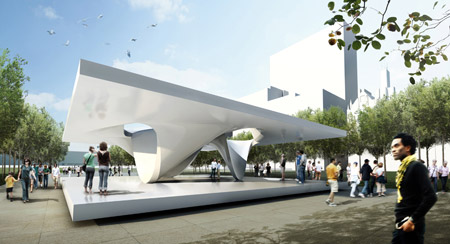
The structure, along with a second designed by Zaha Hadid, will be erected in the park from 19 June to 31 October. Update 16/04/09: see our story on Zaha's pavilion here.
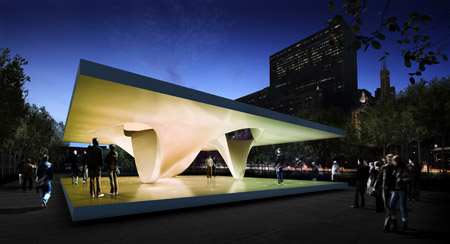
The pavilions will celebrate the centenary of 1909 Plan of Chicago, also known as the Burnham Plan, which set out ways to improve the city.
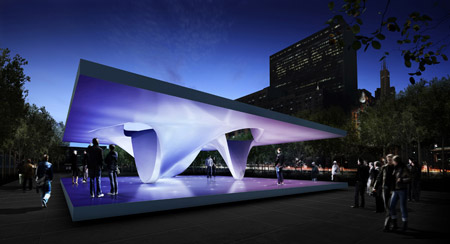
Visualisations by Moka.
Here's a statement from UNStudio followed by all you'll ever need to know about the Burnham Plan Centennial:
--
UNStudio, Burnham Pavilion, Chicago
Placed on a unique location in the middle of Millennium Park and framed by Lake Michigan on one side and Michigan Avenue on the other, the UNStudio pavilion relates to diverse city-contexts, programs and scales. Programmatically the pavilion invites people to gather, walk around and through and to explore and observe. The UNStudio pavilion is sculptural, highly accessible and functions as an urban activator.
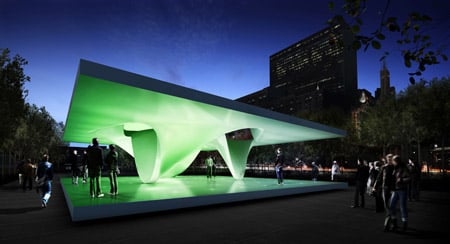
Based on the specificity of the site, the design of the pavilion elaborates on the relationship to the existing rigid geometry, but it also introduces a floating and multi-directional space. It orients itself to the city texture, to the flows of visitors exploring Millennium Park and most importantly introduces diverse vistas towards the park and city surroundings. The pavilion is open at its sides, between the two horizontal planes of the podium and roof.
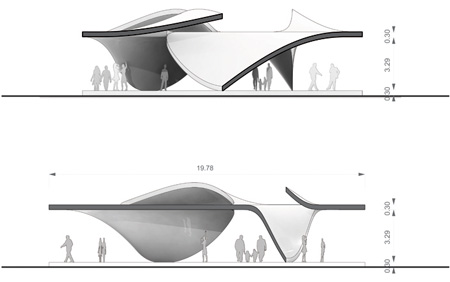
The design of the UNStudio pavilion initially uses the orthogonal setup of the city and park grid. The edges of the pavilion follow the strict grid system of the surrounding city and park geometry. Burnham’s Plan one hundred years ago introduced this generic grid as the main generator of the city texture. However alongside this he also introduced a device to read both specificity and variation in the form of the diagonal boulevards, thereby creating specific vistas throughout the city.
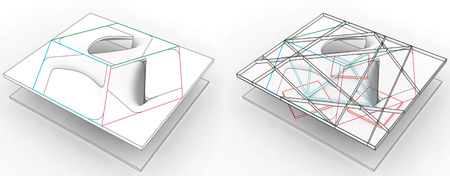
The UNStudio pavilion operates in a similar way, but in contrast uses the entire spectrum of 360 degrees. Instead of Burnham’s tectonic layering of the city, the pavilion introduces a gradient between its ingredients of floor, wall and ceiling in a floating and continuous form. The hierarchy of the horizontal or vertical plane is converted into an understanding of a space as continuous transformation and fluidity. The initially horizontal panorama on top of the pavilion’s podium smoothly shifts diagonally into the three roof openings, framing vertical views of the city skyline. The ambivalence of directionality and the introduction of continuous flow in the structure allows for a smooth opening-up of spaces, directions and, importantly, the most diverse vistas from which to frame and read the city context.
Material:
- Main: Steel structure of columns in the three “legs” of the pavilion and horizontal steel beams
-Secondary: wooden rib structure to form smooth geometry
-Third: plywood paneling to form skin of pavilion
-Finish: bondo (=elastic plaster) and paint
Light installation:
To emphasize the shape and geometry of the building also through the night, a sophisticated lighting device is introduced. Built into the podium of the pavilion, a system of 49 LED lights illuminates the fluid forms of the structure in between the two horizontal levels of podium and roof. In real-time the ever changing animation of light varies in intensity, color and, interactively, the rhythm of activation.
Project credits:
UNStudio
Ben van Berkel, Caroline Bos with Christian Veddeler, Wouter de Jonge and Hans-Peter Nuenning, Ioana Sulea
Garofalo Architects.
Douglas Garofalo with Grant Gibson
Profile UNStudio
UNStudio, founded in 1988 by Ben van Berkel and Caroline Bos, is a Dutch architectural design studio specializing in architecture, urban development and infrastructural projects. The name, UNStudio, stands for United Network referring to the collaborative nature of the practice. At the basis of the practice are a number of long-term goals, which are intended to define and guide the quality of our performance in the architectural field. We strive to make a significant contribution to the discipline of architecture; continue to develop our qualities with respect to design, technology, knowledge and management and to be a specialist in public network projects. We see as mutually sustaining the environment, market demands and client wishes that enable our work, and we aim for results in which our goals and our client’s goals overlap.
The office is composed of individuals from all over the world with backgrounds and technical training in numerous fields. As a network practice, a highly flexible methodological approach has been developed which incorporates parametric designing and collaborations with leading specialists in other disciplines. Drawing on the knowledge found in related fields facilitates the exploration of comprehensive strategies which combine programmatic requirements, construction and movement studies into an integrated design.
Based in Amsterdam, the office has worked internationally since its inception and has produced a wide range of work ranging from public buildings, infrastructure, offices, residential, products, to urban masterplans. Pivotal UNStudio projects within these fields include; the New Mercedes-Benz museum in Stuttgart (2001- 2006), the Galleria Department Store in Seoul (2005), the private family house VilLA NM in Upstate New York (2002-2007), the Agora Theater in Lelystad (2004-2007) and the Erasmus Bridge in Rotterdam (1990-1996).
--
Bold Architectural Designs to Highlight Burnham Plan Centennial in Millennium Park
Dramatic designs of temporary installations by renowned British and Dutch architects unveiled
Chicago, April 8, 2009 – Alderman Brendan Reilly and chairs of the Burnham Plan Centennial Committee made public today two temporary architectural pavilions that will be installed this June in Millennium Park, to symbolize the forward-looking agenda of the 220 organizations that are actively commemorating this year’s 100th anniversary of the Plan of Chicago.
The architects’ rendering of the two recyclable pavilions that will open June 19 and be up through October 31 on the park’s South Chase Promenade were released at a meeting hosted by the Alderman’s office, the Burnham Committee, the City of Chicago Department of Cultural Affairs, the Art Institute of Chicago and Friends of Downtown.
Both architectural exhibits—one designed by London-based Zaha Hadid and the other by Amsterdam-based Ben van Berkel of UNStudio—emphasize the importance of boldly imagining a better future for all, as Daniel Burnham and Edward Bennett did in 1909 by capturing the Chicago spirit of making bold plans and big dreams in their Plan of Chicago.
One pavilion’s curvilinear formal geometries engage state-of-the-art fabric technologies; the other’s floating roof offers surprising views of the Chicago skyline. Both are designed to echo the audacity of the Burnham Plan, which proclaimed, “What we as a people decide to do in the public interest we can and surely will bring to pass.”
“These temporary pavilions make bold statements about Chicago’s ambitious, forward-thinking spirit that was associated with Burnham’s day and the ‘Yes-We-Can’ spirit of today’s Chicago,” Alderman Reilly said. “These two temporary architectural pieces will serve as shining examples of our city’s ongoing commitment to making bold plans and our long tradition of thinking outside of the box, with an eye toward the future.”
Millennium Park board chairman John H. Bryan, who also serves as Centennial Committee co-chair, said, “Public art and visionary design are necessary for any city intending to play a global leadership role in the 21st century. These two Burnham pavilions make bold statements to the world, as did Millennium Park, about Chicago’s confidence in its future.”
Centennial Committee co-chair George A. Ranney also serves as president and CEO of Chicago Metropolis 2020, which has organized the three-state Centennial involving hundreds of future-oriented programs, events, exhibitions, regional planning and environmental-enhancement initiatives.
Ranney said, “While the Millennium Park pavilions create a focal point for the Burnham Centennial, our underlying intent in commissioning them is to motivate the millions of people who experience them to get personally and actively involved in enhancing our regional environment, improving our quality of life, and insisting that our leaders do what is necessary to keep our region economically prosperous. The business community has invested in the Centennial because it knows that what is at stake here is metropolitan Chicago’s ability to compete globally for jobs and investment.”
Centennial vice chair Adele Simmons, who is also vice chair of Metropolis, said, “While the Burnham Centennial is indeed about the serious business of building a better future, it will also be entertaining, educational and enjoyable. More than 220 organizations throughout the three- state region will be offering hundreds of programs, exhibits, and events that use the accomplishments of Chicago’s audacious past as inspiration to achieve a new generation’s big dreams for the future. The energy and excitement of the Burnham pavilions will inspire people to think ‘out of the box’ about our metropolis and our future.”
The recyclable pavilions will be built locally of steel donated by ArcelorMittal and of aluminum donated by Marmon/Keystone Corporation—both companies have an important presence in Chicago. Assembly of the UNStudio Pavilion will be handled by Third Coast Construction, a local leader in green contracting, with TenFab Design providing the tensioned fabric construction of the Hadid Pavilion. The UNStudio pavilion will be de-constructed and recycled. The Hadid tent-like structure can be dismantled and re-installed at another location following the Centennial.
Ben van Berkel is a rising star of inventive, computer-aided architecture with a special interest in the integration of construction and architecture. He studied architecture at the Rietveld Academy in his native Holland and at the Architectural Association in London, receiving the AA Diploma with honors in 1987. His first projects were built almost immediately after founding Van Berkel & Bos Architectuur Bureau. His collaborative approach led to the foundation in 1999 of UNStudio, which includes his wife and business partner art historian Caroline Bos. The firm works on a wide range of projects varying from urban infrastructure to buildings, interiors, and product design. His selection to design the Erasmus Bridge in Rotterdam in 1996 profoundly affected his understanding of the role of the architect. The Mercedes-Benz Museum in Stuttgart (2006) and the Music and Performing Arts Theater in Graz are examples of recently realized projects by Ben van Berkel.
The sculptural UNStudio pavilion is highly accessible and functions as an urban activator. Framed by Lake Michigan on one side and Michigan Avenue on the other in its Millennium Park setting, the UNStudio pavilion relates to diverse city-contexts, programs and scales. Programmatically the pavilion invites people to gather, walk around and through the space and to explore and observe.
Zaha Hadid’s dramatically fluid and technically innovative work is increasingly seen around the world in an array of remarkable buildings. Hadid is the only female recipient of the Pritzker Prize for architecture. She was born in Baghdad, Iraq, and educated in mathematics at the American University of Beirut, Lebanon. She studied architecture in London at the Architectural Association under Rem Koolhaas and Elia Zenghelis, winning the AA Diploma Prize in 1977. From the first, Hadid defined new limits of the buildable, transforming our vision of the future with new spatial concepts and bold visionary forms. On its opening in 2003, the New York Times described Hadid’s Rosenthal Center for Contemporary Art in Cincinnati as “the most important American building to be completed since the end of the cold war.” Among her projects worldwide, Hadid is currently working on the Eli and Edythe Broad Art Museum at Michigan State University, while her academic appointments include the Sullivan Chair at the University of Illinois Chicago School of Architecture. Her practice, Zaha Hadid Architects, is headquartered in London.
The interior of the Hadid Pavilion will serve as a screen for an immersive video installation created by UIC-trained and London-based artist Thomas Gray for The Gray Circle that tells the story of Chicago’s transformation, including visions for the future by local architects. An accompanying exhibit in September entitled “Bold Plans. Big Dreams. Chicago Architects.” Presented by the City of Chicago Department of Cultural Affairs nearby at 72 East Randolph will feature visionary works by dozens of local architects and designers.
In addition to experiencing and touring the Pavilions this summer, visitors are encouraged to visit www.burnhamplan100.org to plan exciting experiences throughout the region—from the Chicago Architecture Foundation and the Art Institute of Chicago adjacent to Millennium Park, to more than 50 libraries that plan to host an exhibit curated by the Newberry Library. Community organizations, leadership groups and public officials are all playing a role.
Millions of visitors are expected to see the Burnham Pavilions this summer, especially since they are adjacent to the new wing of the Art Institute of Chicago and its Nichols Bridgeway into Millennium Park.
The Pavilions were made possible by the generous support and civic commitment of the Burnham Leadership Group including (to date): Mr. and Mrs. John H. Bryan, Mr. and Mrs. Wesley M. Dixon, Mr. and Mrs. Marshall Field V, Margot and Thomas Pritzker, Patrick G. Ryan and Shirley W. Ryan, and The Crown Family. The Committee would also like to recognize the following companies for their contributions to help make the Burnham Pavilions possible: Official Airline Sponsor, British Airways; Official Steel Sponsor, ArcelorMittal; and Aluminum Sponsor, Marmon/Keystone Corporation, a member of The Marmon Group of companies; as
well as the Consulate General of the Kingdom of the Netherlands. National City, now a part of PNC, is the Official Sponsor of the June 19 public opening events. Lodging has been generously provided by the Union League Club and Village Green at the Fisher Building and MDA City Apartments, and graphic design services have been contributed by VSA Partners.
Installation of the Pavilions is a collaboration of the Burnham Plan Centennial Committee, Chicago Metropolis 2020, the City of Chicago Department of Cultural Affairs, Millennium Park, Inc. and the Art Institute of Chicago. Architecture students at the Illinois Institute of Technology and the University of Illinois at Chicago have had the opportunity to learn from these internationally renowned architects who are part of the project.
About the Burnham Plan Centennial Committee
John Bryan, retired chief executive of Sara Lee Corporation, and George A. Ranney, chief executive officer of Chicago Metropolis 2020, are Committee co-chairs. Vice chair is Adele Simmons, vice chairman and a senior executive of Chicago Metropolis 2020. The 26 members of the Committee represent major companies, civic organizations, and cultural and educational institutions from throughout the region.
The committee is orchestrating the Centennial and convening the many communities, municipalities, organizations, schools, institutions and others that will plan related programs. Staff support is provided by Chicago Metropolis 2020, a business-backed civic organization founded by the Commercial Club of Chicago. The Commercial Club sponsored the original Plan of Chicago by Daniel H. Burnham and Edward H. Bennett.
In addition to the generous donors to the Burnham Pavilions (listed above), The Chicago Community Trust, our region's community foundation, provided leadership funding for the Burnham Plan Centennial. The Trust is joined as a founding sponsor by The Elizabeth Morse and Elizabeth Morse Genius Charitable Trusts. Organizational and staff support for the Burnham Plan Centennial Committee is provided by Chicago Metropolis 2020. The Burnham Plan Centennial Committee also gratefully acknowledges the following for their support of the Centennial: Presenting Sponsor for the Environment, the Exelon Foundation; Presenting Sponsor for Education, Polk Bros. Foundation; Presenting Sponsor for Transportation, the John D. and Catherine T. MacArthur Foundation; all of our supporters at the Burnham Circle level including The Allstate Corporation, Gaylord and Dorothy Donnelley Foundation, McCormick Foundation, the Hamill Family Foundation, Northern Trust; and all of our supporters at the Bennett Circle level including The Boeing Company and The Commercial Club of Chicago. We also gratefully acknowledge the in-kind support of our communications partner Hill & Knowlton and media partner WTTW.
About Chicago Metropolis 2020
Chicago Metropolis 2020 is a nonprofit civic organization created in 1999 by The Commercial Club of Chicago to promote long-term planning, better regional cooperation, and smart investments in the Chicago region and its people.
About Millennium Park
Millennium Park is an award-winning center for art, music, architecture and landscape design. The result of a unique partnership between the City of Chicago and the philanthropic community, the 24.5-acre park features the work of world-renowned architects, planners, artists and designers. Among Millennium Park's prominent features are the Frank Gehry-designed Jay Pritzker Pavilion; the Crown Fountain by Jaume Plensa; the Lurie Garden and Anish Kapoor's hugely popular Cloud Gate sculpture. For more information, visit www.millenniumpark.org